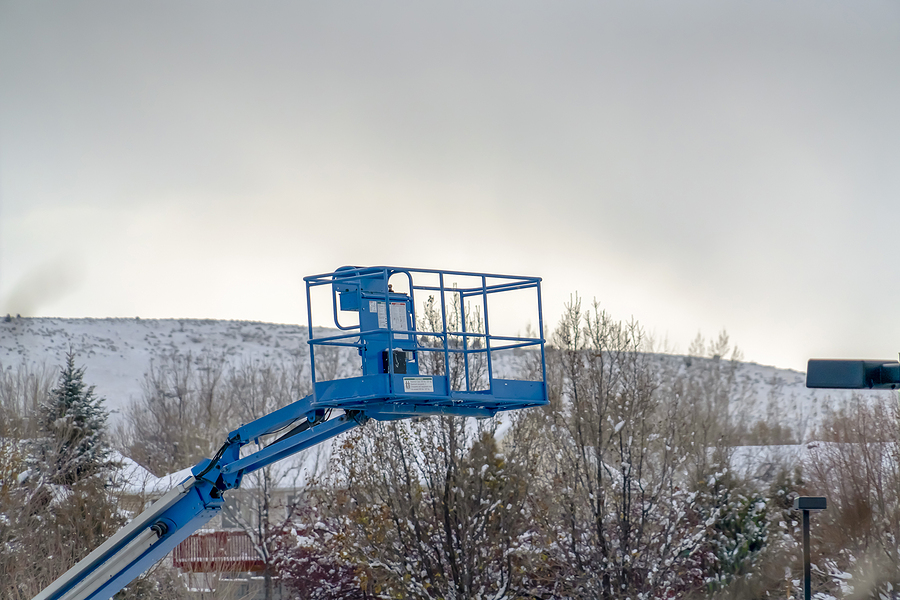A quick, but complete guide on lift safety during icy conditions
While the New Year may have begun, the frost is hardly off the trees yet. In light of the new year and the new normal we are embracing, many projects are being green-lit once again after a season or more of project delays. Now may be the perfect time to rent a lift and other equipment to complete any of your above-ground (up in the air) work that needs doing.
Whether you’re repainting a house, remodeling a business, trimming trees or something even more interesting, it’s vital to make sure you’re using your lift safely. In the winter months and the icy springtime, you’ll need to take a few extra precautions to keep both the lift and those using the lift safe throughout your project. Here is a quick and complete guide on lift safety in icy conditions.
Lay Down Grit Where the Lift Will be Operating
First things first, grit your workspace. Whether you prefer salt, gravel, or chemical de-icer, the important thing is to reduce ice and increase traction. This is important for the lift, to ensure the vehicle can move freely without risk of the wheels slipping. The lift needs to be able to both move safely and remain absolutely in place when your team is up in the basket or on the platform. The grit will also helpfully increase the general safety of your worksite for all people and vehicles on the ground.
Warm Up Before Lifting
Warm up your lift before you raise the basket. Start the engine and go through the necessary process to begin the warm-up. Hydraulics, like most machinery, works best when it is above freezing temperature. This will improve efficiency and safety, reducing wear-down; it also reduces your fuel costs for running the lift once it’s warm.
Monitor Fluids for Freezing
Almost any fluid can freeze or become sludgy in freezing temperatures. You can count on a rented lift to already be equipped with winter-weight oil but the diesel has a risk of becoming gummed up in a frozen engine. Check your engine before getting started and warm up the engine with an engine block or blanket if necessary.
Move at Half-Speed & Anchor Securely
Go slow. Don’t move the lift vehicle quickly over land and take extra time to raise the lift safely. The winter poses a number of potential risks and the best way to avoid all damage is to take it slow. If anything starts to become a problem, you can stop immediately and fix it before anyone becomes hurt or any equipment gets damaged. But only if you’re going slow enough to stop without momentum.
Survey and Triple-Check Site Preparation
Before you begin, and as you progress to each stage of the project, check the site. Check and grit an area of pavement before moving the lift. Make sure your tree and power line clearance before raising the basket. Also check that no frost has formed on the structure before bringing down the basket. If you get a feeling like something might or could be wrong, it’s worth an extra check just to keep everyone safe in icy conditions.
Bundle Up Anyone Going Up the Lift
Keep everyone warm. Winter projects are always bitingly cold, and going up in a lift takes you into the freezing icy air. Make sure anyone going up is wearing sturdy work gloves, plenty of warm clothing, and shoes with good traction. Because winter winds can be stronger and colder up there, wear ear and face protection in addition to warm hats.
Use Fall-Prevention Harnesses & Tethers
Do not risk a fall. Even if your lift is only going up a few feet, we strongly recommend that anyone going up also wear a harness and fall-prevention tether. Harnesses ensure that even if someone slips or is blown out of the basket, they won’t be harmed by the fall. Never skip on the fall protection, especially when the road and everything around you is covered in ice.
Shelter or Cover Lifts When Parked
Finally, be sure to shelter your lift and other equipment when it’s not in use. Don’t leave equipment out in the elements where falling snow or worse could work frozen moisture into the machinery. If possible, park your lift in a sheltered area, especially in icy conditions. If not, consider throwing a cover over your equipment to protect it from the elements during breaks or phases of disuse in your winter project.
Looking to rent a lift this winter or spring, along with other equipment for your project? We are proud to provide helpful equipment rentals in your area. Contact us today to discuss your project and reserve the equipment you’ll need.


